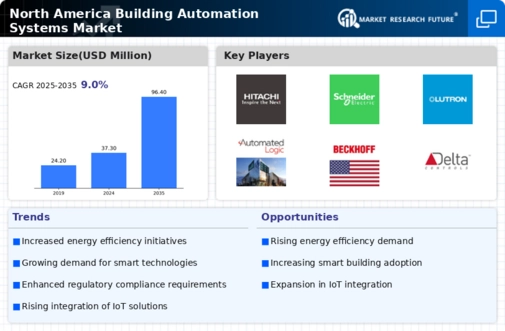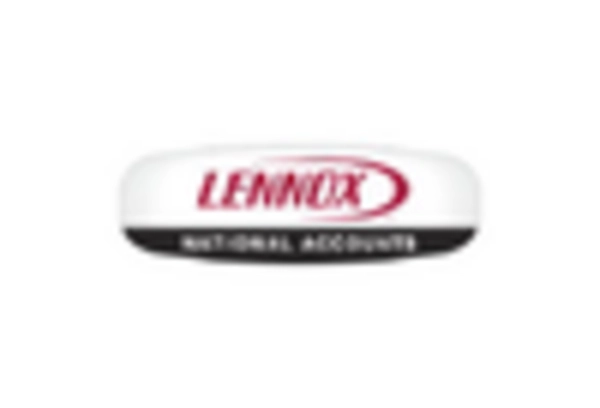Advancements in Cloud Computing
Advancements in cloud computing are significantly impacting the North America Building Automation Systems Market. The shift towards cloud-based solutions allows for enhanced data storage, accessibility, and analytics capabilities. Building owners and facility managers can leverage cloud technology to monitor and control building systems remotely, leading to improved operational efficiency. Furthermore, cloud-based platforms facilitate the integration of various building systems, enabling seamless communication and data sharing. As organizations increasingly adopt cloud solutions, the market is likely to see a surge in demand for building automation systems that offer cloud connectivity, thereby enhancing overall system performance and user experience.
Increased Focus on Sustainability
Sustainability has become a pivotal concern within the North America Building Automation Systems Market. Organizations are increasingly prioritizing sustainable practices, which has led to a heightened interest in building automation systems that promote energy efficiency and resource conservation. The push for green buildings and sustainable construction practices is influencing the market, as stakeholders recognize the long-term benefits of investing in energy-efficient technologies. Data suggests that buildings equipped with advanced automation systems can achieve up to 40% energy savings compared to traditional systems. This focus on sustainability not only aligns with corporate social responsibility goals but also enhances the overall value of properties.
Integration of Smart Technologies
The North America Building Automation Systems Market is witnessing a notable shift towards the integration of smart technologies. This trend is driven by the increasing demand for advanced control systems that enhance operational efficiency and reduce energy consumption. Smart technologies, such as artificial intelligence and machine learning, are being incorporated into building automation systems to optimize performance and predictive maintenance. According to recent data, the market for smart building technologies is projected to grow significantly, with estimates suggesting a compound annual growth rate of over 10% in the coming years. This integration not only improves energy management but also enhances occupant comfort, making buildings more responsive to user needs.
Regulatory Compliance and Standards
Regulatory compliance plays a crucial role in shaping the North America Building Automation Systems Market. Governments are increasingly implementing stringent regulations aimed at improving energy efficiency and reducing carbon emissions. These regulations compel building owners and operators to adopt advanced automation systems that comply with energy codes and standards. For instance, the implementation of the Energy Policy Act has led to a surge in demand for building automation solutions that facilitate compliance. As a result, the market is expected to expand as organizations seek to meet these regulatory requirements while also benefiting from potential cost savings associated with energy-efficient systems.
Growing Demand for Energy Management Solutions
The North America Building Automation Systems Market is experiencing a growing demand for energy management solutions. As energy costs continue to rise, businesses and organizations are increasingly seeking ways to optimize their energy usage. Building automation systems equipped with energy management capabilities allow for real-time monitoring and control of energy consumption, leading to significant cost savings. Recent statistics indicate that energy management systems can reduce energy costs by up to 30%. This trend is further fueled by the increasing awareness of sustainability and the need for organizations to reduce their carbon footprint, thereby driving the adoption of advanced building automation technologies.
















Leave a Comment